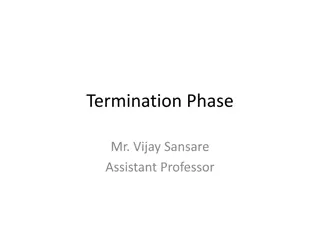
Improving Unemployment Insurance with Blockchain Technology: A Case Study of BeneChain Cryptoventures
Explore how BeneChain Cryptoventures revolutionizes the Unemployment Insurance system by implementing blockchain technology to reduce inefficiencies, prevent fraud, and optimize benefit administration. Dive into the transition from manual processes to a secure, transparent, and automated future state, enhancing stakeholder visibility and operational efficiency.
Download Presentation

Please find below an Image/Link to download the presentation.
The content on the website is provided AS IS for your information and personal use only. It may not be sold, licensed, or shared on other websites without obtaining consent from the author. If you encounter any issues during the download, it is possible that the publisher has removed the file from their server.
You are allowed to download the files provided on this website for personal or commercial use, subject to the condition that they are used lawfully. All files are the property of their respective owners.
The content on the website is provided AS IS for your information and personal use only. It may not be sold, licensed, or shared on other websites without obtaining consent from the author.
E N D
Presentation Transcript
Logo BeneChain BeneChain Cryptoventures Spring 2017 Team 5 Wes Day, Amar Jain, Jimmy Kozlow, Trey Lundgren
Table of Contents 1. Cover Page 2. Table of Contents 3. Problem Statement & Market Size 4. Existing State Process 5. Future State Process 6. Implementation of Blockchain Technology 7. Advantages of Using Blockchain 8. Implementation & Rollout 9. Business Model & Monetization 10. Financial Model 11. Risk Analysis 12. Competitive Analysis 13. Future Opportunities 14. Timeline & Next Steps 2
Quantifying waste, fraud, and error in the US government Unemployment Insurance System Unemployment Insurance (UI) has the fifth highest rate of improper payments among all government departments In 2015: $3.5B in improper payments || 10.7% of UI Benefits Improper Payment Rate - By State Causes of improper payments include: Payments to claimant continue after individuals have returned to work Failure or claimant to register for reemployment services Failure of employers to timely or correctly report on worker separation Inaccurate calculation of benefits based on wages earned prior to unemployment Source: https://dupress.deloitte.com/dup-us-en/multimedia/interactives/fraud-waste-and-abuse-in-entitlement-programs-benefits-fraud.html 3
Existing Process Unemployment Insurance is administered at the state level 1 Federal Unemployment Benefit Fund Administered by States ER Report Manual Processes High Admin Costs ER Report EE Report EE Report 4 Employee Hired at Co. 2, Benefits stop EE Report Time Delay 2 Employee Terminated Co. 1 Both parties report 2 Weeks Fees 3 Benefits Start, Job Search 4
Future State - Blockchain based solution reduces admin needs and increases visibility across stakeholders Federal and state funds managed on private blockchain 1 ER Report ER Report EE Report EE Report 4 Employee Hired at Co. 2, Benefits stop 2 Employee Terminated Co. 1 EE Report Automated 3 Benefits Start, Job Search Fedcoin for benefit funding 5
How will blockchain technology be implemented? Permissioned Blockchain, Ethereum Protocol Termination Report 1 4 Ex- New Employer Employer files termination report (see contents below) to register change in employment status. New employer confirms that employee has been rehired. Employer New Validation Employee Report 5 2 Once re-employed, smart contract validation terminates benefits. Claimant must validate status and confirm they are seeking re- employment services. Claimant Claimant Claim Request Claim request is initiated via ETH smart contract. Smart Contract If valid, benefits are administered. Contents of Termination Report Notifications Benefits Info: Employee ID Employer ID Reason of Termination Salary Date of Employment 3 State agency receives notifications of benefits as they are administered and as they expire. State Agency Data collected and used to analyze improper payments. 6
Blockchain technology be advantageous for each stakeholder group and meets key criteria for implementation Five criteria for using blockchain applications: Transparency with privacy Reduces improper payments from manual reporting Employers Distributed Ledger Multiple states and agencies require read/write access Remote Independent Writers Each party must contribute to share information Improved efficiency Benefits can be received <two weeks Benefits can also be applied retroactively Claimants Existence in Absence of Trust BeneChain BeneChain Causing Disintermediation Blockchain technology reduces touchpoints and effort required to manage Allows multiple parties to write to the system without burdensome oversight Reduction in fees paid to third parties (banks, Visa, etc..) State Agencies Economic Benefits for Participants Major savings opportunity to reduce admin costs and improper payments 7
The first implementation of Benechain will focus on one state. If successful, expansion will follow Single State POC (NC) Hybrid database/blockchain solution 3 Key Parties: Employers, Claimants, US Dept. Labor Validate process and cooperation among parties Multi-State Unemployment Insurance (UI) Ethereum Solution Full blockchain solution; distributed ledger network for all states Each state represents a node on the private UI blockchain Full State Adoption Under Federal solution In Future: Fed Coin could be used to administer payments 8
Business Model & Monetization Strategy Cyclical Revenue Model Opportunity for Immediate Monetization Implementation Contract: Charge pilot state - NC (and successive partner states) a platform development, implementation, and training fee commensurate with comparable IT system implementations Implementation Contract Transaction Fees: Extract minimal transaction fee from state (<$1) every time a new record (initial claim, job offer, etc.) is written to the blockchain by an employer; in this model, states could seek direct reimbursement from companies, or pay fees with admin $ saved by program Ongoing Services Transaction Fees Ongoing Services: Receive revenue from ongoing maintenance of state systems, training/consulting on Benechain updates, and eventual move to 100% blockchain solution This three phase model is repeatable across every additional state (and benefit program) Benechain supports and provides a certain level of stability in cash flows 9
Financial Implications North Carolina Use Case High Level Revenue Projections Some Important NC Unemployment Statistics*: Only Includes State Level Unemployment Systems 10 Year 5 Year Avg. Weekly Initial Unemployment Claims: ~5,250 Unemployment Average. = 7.4% Improper Unemployment Payments: >14% October 2015 Total Benefits Paid: $17.5 M 5 Year Average Annual Unemployment Benefits $321 M x Estimated Fraudulent Payment % 15% = Annual Estimated Fraudulent Payments $48 M Revenue Source (Avg. State) Est. Contribution + Annual Estimated Card Fees (@1.5%) $5 M Implementation Charge ~$250k = Total Annual Addressable Program Costs $53 M Transaction Fees $205k (annually) Annual Estimated Benechain Cost Savings** $35 M Ongoing Services ~$35k (annually) *Source of all information: United States Department of Labor; North Carolina Division of Employment Security **Assumes fraudulent payments reduced to 5% and transaction fees reduced to .5% as a result of Benechain solution 10
Risk Analysis Risk: Political climate prevents implementation Description: This initiative requires funding and buy-in from congress and government agencies Mitigation: Seek bipartisan supporters within state and federal ranks. Maintain a narrow focus early to demonstrate benefit early on, which can help drive adoption rates as expansion occurs. Risk: The improper payment rate increase in the short term Description: New data allows for more thorough analysis of waste, identifying more improper payments than the agency was aware of before Mitigation: Incorporate data analytics and predictive models into the product to increase transparency during and right after implementation. Communicate this paradox and early and often Risk: People will find new ways around the system Description: Fraud is dynamic and people will always adapt to find new ways to take advantage of the system Mitigation: Create a learning system that responds to ever changing threats. Deloitte suggests this strategy and it can be implemented using the data from the blockchain. Statistical models can help define business rules that can constantly search the system for potential improper payments 11
Competitive Analysis Direct Competition DISC Holdings London based firm previously known as GovCoin Worked on a 6 month pilot for UK Gov t to rollout welfare benefits through Blockchain, claimed it was a success Known to work on a broader pilot program as of today Potential Competition Companies that provide Blockchain enterprise services could be a potential threat due to low barriers to entry Companies with advanced smart contract implementations capabilities are a threat as well 12
Future opportunities for Benechain include implementation across to other gov. agencies Longer Term Plans & Additional Application Opportunities (2+ years away) Multi-State Rollout : Expand Benechain beyond North Carolina by targeting other states in the region who also have large % s of improper unemployment payments Fed Coin Currency: Champion implementation of proposed currency to interact with Benechain applications and expand use of blockchain for benefits nationwide Food Stamps: Provide more secure (and less expensive) method of managing and distributing nutritional benefits through blockchain solutions Social Security: Expand solutions to larger, Federal level programs, such as Social Security, where blockchain can make wage record and benefit distribution more transparent 13
Benechain rollout will ramp up over the next 1-2 yrs Next Steps (next 1-2 Years) A B C D E F 2017 2018 2019 A. Secure additional funding to continue building out team with coding talent and business development professional(s) in anticipation of pilot implementation B. Secure contract with state of North Carolina to build hybrid blockchain/database system & continue to refine platform technology and capabilities C. Onboard North Carolina platform and train state employees to use system and communicate new requirements to companies employing people in the state D. Facilitate seminars on new documentation requirements and beta test Benechain NC; outreach to additional state employment agencies in the South East (likely TN & SC) E. Begin writing and storing employment and unemployment records on the platform F. Begin contractual process with additional state employment agencies in the South East 14






















